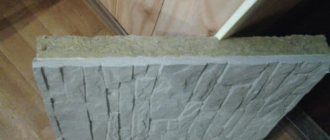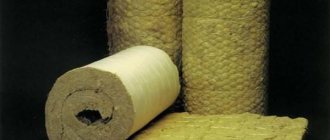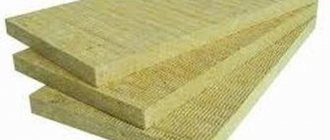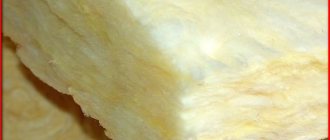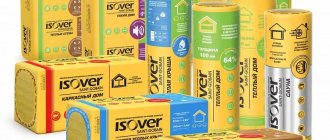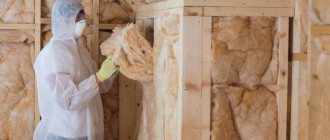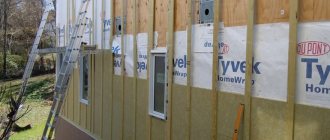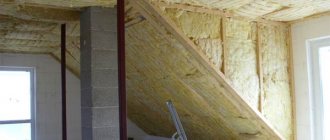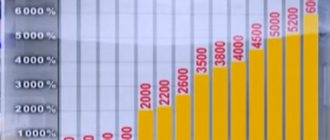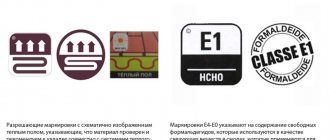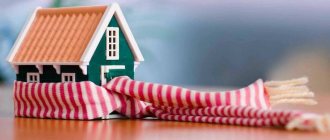Warm floor - what is it?
The warm floor consists of mats and a heating system.
The first heated floor surfaces were used by the ancient Romans to heat baths. Hot air passed through special channels installed under the floor. The principle of modern heating designs has remained the same, but during this time the heating system has been significantly improved. The design is used for installation in premises of any purpose; it is considered an excellent alternative to conventional central heating. Efficiency is achieved due to increased heat transfer. Installation of the structure does not take much time; the procedure can be carried out in any room.
Choose what you need
Despite the fact that the production of Penoplex with technical characteristics corresponding to those declared is carried out by many manufacturers, one should take a responsible approach to the choice of the “homeland” and “parent” of the insulation. One should not discount the need to choose it to achieve maximum insulation in a particular case for certain conditions, materials, surfaces.
When selecting, you need to focus on:
- brand and series of heat insulator required for the work;
- the size of the slabs, especially if you plan to insulate a small room;
- the density of Penoplex slabs, which should not be less than 25 kg/m3 (the quality of insulation and strength depend on this indicator);
- manufacturer's brand;
- block packaging (it must be intact, which guarantees the integrity of the slabs).
If in doubt, read the characteristics on the Penoplex packaging. The description contains all the necessary data to make a selection decision.
If you are in doubt about the indicated density, weigh the slabs to determine the density yourself, subsequently dividing the weight by the volume. For example, a Comfort slab with a thickness of 50 mm and normal density should not weigh less than 1.3 kg. At the fracture of the “regular” Penoplex, you can see many polyhedra of regular shape, along the boundaries of which the fracture occurs. The fracture should be orange due to the coloring pigment included in the composition. Purchasing products from well-known European factories will guarantee the quality of the products. The domestic manufacturer, represented by the Penoplex and TechnoNIKOL enterprises, is not far behind them.
After reading about penoplex, understanding what it is, where it can be used, assessing its pros and cons, you can be confident in the targeted choice of the right brand and in its correct use. Having done insulation once using Penoplex, ensure that heat is retained in the house for many years.
What does thermal conductivity depend on?
The ability of polystyrene foam boards to retain heat depends mainly on two factors: density and thickness. The first indicator is determined by the number and size of air chambers that make up the structure of the material. The denser the slab, the greater the thermal conductivity coefficient it will have.
Density dependence
In the table below you can see exactly how the thermal conductivity of expanded polystyrene depends on its density.
| Density (kg/m3) | Thermal conductivity (W/mK) |
| 10 | 0.044 |
| 15 | 0.038 |
| 20 | 0.035 |
| 25 | 0.034 |
| 30 | 0.033 |
| 35 | 0.032 |
The background information presented above, however, most likely, can only be useful to home owners who have used polystyrene foam to insulate walls, floors or ceilings for quite some time. The fact is that when producing modern brands of this material, manufacturers use special graphite additives , as a result of which the dependence of thermal conductivity on the density of the plates is reduced to almost nothing. You can verify this by looking at the indicators in the table:
| Brand | Thermal conductivity (W/mK) |
| EPS 50 | 0.031-0.032 |
| EPS 70 | 0.033-0.032 |
| EPS 80 | 0.031 |
| EPS 100 | 0.03-0.033 |
| EPS 120 | 0.031 |
| EPS 150 | 0.03-0.031 |
| EPS 200 | 0.031 |
Dependence on thickness
Of course, the thicker the material, the better it retains heat. For modern expanded polystyrene, the thickness can range from 10-200 mm. According to this indicator, it is usually classified into three large groups:
- Plates up to 30 mm. This thin material is usually used to insulate partitions and interior walls of buildings. Its thermal conductivity coefficient does not exceed 0.035 W/mK.
- Material up to 100 mm thick. Expanded polystyrene of this group can be used for cladding both external and internal walls. Such stoves retain heat very well and are successfully used even in regions of the country with a harsh climate. For example, a material 50 mm thick has a thermal conductivity of 0.031-0.032 W/Mk.
- Expanded polystyrene with a thickness of more than 100 mm. Such dimensional slabs are most often used for the manufacture of formwork when pouring foundations in the Far North. Their thermal conductivity does not exceed 0.031 W/mK.
Calculation of the required material thickness
It is quite difficult to accurately calculate the thickness of polystyrene foam needed to insulate a house. The fact is that when performing this operation, a lot of different factors should be taken into account. For example, such as the thermal conductivity of the material chosen for the construction of insulated structures and its variety, the climate of the area, the type of cladding, etc. However, it is still possible to approximately calculate the required thickness of the slabs. To do this you will need the following reference data:
- an indicator of the required thermal resistance of enclosing structures for a given specific region;
- thermal conductivity coefficient of the selected brand of insulation.
Actually, the calculation itself is carried out according to the formula R=p/k, where p is the thickness of the foam, R is the thermal resistance index, k is the thermal conductivity coefficient. For example, for the Urals the R indicator is 3.3 m2•°C/W. Let’s say that a material of the EPS 70 brand with a thermal conductivity coefficient of 0.033 W/mK is selected for wall insulation. In this case, the calculation will look like this:
- 3.3=p/0.033;
- p=3.3*0.033=100.
That is, the thickness of the insulation for external enclosing structures in the Urals should be at least 100 mm. Typically, home owners in cold regions sheathe walls, ceilings and floors with two layers of 50 mm polystyrene foam. In this case, the slabs of the upper layer are positioned so that they overlap the seams of the lower one. This way you can get the most effective insulation.
Types, characteristics, properties
Penoplex is available in several categories:
Comfort. For insulation of walls, balconies, loggias. Foundation. Pitched roof. Wall.
Types and purpose of Penoplex insulation
As you can see, the manufacturer clearly delineates the areas of application of the material. With the general technology, they differ in density. The densest ones are for the foundation and floor, since they must withstand considerable loads for a long time. The manufacturer claims that the service life of Penoplex Foundation is up to 50 years.
Design differences
Some of the types of Penoplex have structural differences:
- Penoplex Wall slabs have a rough surface; stripes are applied to the surface of the slab using a router. All this improves adhesion to the wall and/or finishing materials.
- Penoplex Comfort is distinguished by an L-shaped edge, which during installation guarantees the absence of through seams.
- Penoplex Roofing has a U-shaped edge, which increases the reliability of the connection.
Can be distinguished by external signs
This is what concerns external differences. Next, consider the technical characteristics
First, let's pay attention to what is common to all types, then to what distinguishes them
General characteristics
Since the production technology of all types of Penoplex is similar, they have many of the same characteristics:
Water absorption is very low:
- when immersed in water for a day, no more than 0.4% of the volume;
- when immersed for 28 days, 0.5% of the volume.
Fire resistance - G4. The material is flammable and should not be used in areas where there is a risk of heating above 80°C.
Flammability is not the best characteristic
Penoplex insulation boards are available in different thicknesses and densities
As you can see, according to temperature indicators, any type of Penoplex can be used in any part of the country - from the south to the north. Moreover, if you leave it to “winter” unprotected, nothing will happen to the material. This is not the merit of Penoplex, but a general property of extruded polystyrene foam.
What distinguishes different types
The manufacturer divided the types of Penoplex into areas of use. Their properties are optimal for a specific application. For example, the increased density of EPS required for a screed will not be needed when installing it on a plinth. Taking into account the fact that the price differs significantly, it makes no sense to use the “Foundation” brand for other purposes. But the difference in locks, with other characteristics being equal, can be neglected. This is about ease of installation.
Although this is also important
| Parameter | Comfort | Foundation | Roof | Wall |
| Density | from 20 kg/m3 | 27-35 kg/m3 | 26-34 kg/m3 | from 20 kg/m3 |
| Elastic modulus | 15 MPa | 17 MPa | 17 MPa | 15 MPa |
| Thickness | 20, 30, 40, 50, 100 mm | 50, 100 mm | 100 mm | 50 mm |
| Static bending strength | 0.25 MPa | 0.4 MPa | 0.4 MPa | 0.25 MPa |
As can be seen from the table, Penoplex for foundations and roofs is denser, stronger, and better able to withstand bending loads. Designed for walls and the “Comfort” brand are less durable, since their area of application does not require resistance to mechanical stress.
Table of thermal conductivity of materials
| Material | Thermal conductivity of materials, W/m*⸰С | Density, kg/m³ |
| Polyurethane foam | 0,020 | 30 |
| 0,029 | 40 | |
| 0,035 | 60 | |
| 0,041 | 80 | |
| Expanded polystyrene | 0,037 | 10-11 |
| 0,035 | 15-16 | |
| 0,037 | 16-17 | |
| 0,033 | 25-27 | |
| 0,041 | 35-37 | |
| Expanded polystyrene (extruded) | 0,028-0,034 | 28-45 |
| Basalt wool | 0,039 | 30-35 |
| 0,036 | 34-38 | |
| 0,035 | 38-45 | |
| 0,035 | 40-50 | |
| 0,036 | 80-90 | |
| 0,038 | 145 | |
| 0,038 | 120-190 | |
| Ecowool | 0,032 | 35 |
| 0,038 | 50 | |
| 0,04 | 65 | |
| 0,041 | 70 | |
| Izolon | 0,031 | 33 |
| 0,033 | 50 | |
| 0,036 | 66 | |
| 0,039 | 100 | |
| Penofol | 0,037-0,051 | 45 |
| 0,038-0,052 | 54 | |
| 0,038-0,052 | 74 |
- Environmentally friendly.
This factor is significant, especially in the case of insulating a residential building, since many materials emit formaldehyde, which affects the growth of cancerous tumors. Therefore, it is necessary to make a choice towards non-toxic and biologically neutral materials. From an environmental point of view, stone wool is considered the best thermal insulation material.
- Fire safety.
The material must be non-flammable and safe. Any material can burn, the difference is at what temperature it ignites. It is important that the insulation is self-extinguishing.
- Steam and waterproof.
Those materials that are waterproof have an advantage, since moisture absorption leads to the fact that the effectiveness of the material becomes low and the useful characteristics of the insulation after a year of use are reduced by 50% or more.
On average, the service life of insulating materials ranges from 5 to 10-15 years. Thermal insulation materials containing cotton wool significantly reduce their effectiveness in the first years of service. But polyurethane foam has a service life of over 50 years .
What kind of insulation should it be?
Since there is no objective data about the allegedly harmful effects of penoplex on humans, we will figure it out ourselves.
When choosing insulation, many buyers, having familiarized themselves with the performance characteristics of the products of PENOPLEX SPb LLC, ask the question: “Is penoplex harmful to health?” There are no words, there is a lot of talk about the harmful effects of penoplex, but let's try to figure it out. The selected insulation for buildings or structures must meet the following requirements:
- the material used should not contain dust and small fibers, which confirms the unfoundedness of statements about the dangers of penoplex for the home, since these factors are absent;
- phenol-formaldehyde resins and similar harmful substances are absent in penoplex, which allows us to give a negative answer to the question: “Is penoplex harmful or not?”;
- whether penoplex is harmful to the environment and human health can be judged on the basis that no means are used in its production that destroy the Earth’s ozone layer;
- When the insulation is used from 50 degrees below zero to 75 degrees above zero, as recommended by the instructions for penoplex, there are no harmful emissions for humans, which is confirmed by the sanitary-epidemiological and environmental conclusion.
- Moisture resistance:
- Wetting of the insulation used in construction work leads not only to a decrease in the level of thermal protection, but also to the formation of fungi and mold, therefore, it is incorrect to talk about the harm of penoplex to human health, given its almost zero water absorption;
- modern penoplex insulation is so resistant to moisture that it is not afraid of either drainage water or swelling soils.
High level of thermal protection: is penoplex harmful or not, the use of which not only creates comfortable living conditions, but also reduces heating costs, because it has an extremely low thermal conductivity coefficient (no more than 0.032 W/m K)? ; high resistance to thermal conductivity makes it possible to achieve a noticeable reduction in heat loss with a slight increase in wall thickness. Compressive strength: the strength of the insulation allows it to be used not only for thermal insulation of walls and roofs, but also to increase the thermal protection of foundations, insulation of floors and plinths that can withstand constant loads; Even prolonged use will not lead to deformation or change in the dimensions of modern insulating material.
Comparison of thermal conductivity of materials
Today, most manufacturers of thermal insulation materials are ready to offer developers a wide range of products. And each of them will assure that the insulation they produce will be the ideal choice. Such a variety of materials for construction makes it difficult to make a decision in favor of one or another heat insulator. Therefore, the purpose of this article is to help you make your own choice by comparing the thermal conductivity of various insulation materials and other key characteristics.
Expert opinion
Konstantin Alexandrovich
First, I would like to draw your attention to the main characteristics of thermal insulators, which are of paramount importance when purchasing. It is more expedient to compare insulation materials when the purpose of the material is known in advance. For example, despite the fact that the strength of extruded XPS is higher than that of mineral wool, it is recommended to purchase fire-resistant insulation near an open flame or when operating at high temperatures for your own safety.
Comparison of the main characteristics of insulation materials
- Thermal conductivity. The lower this material characteristic turns out to be, the smaller layer of insulation you will need to lay. This means that it will be possible to reduce the cost of purchasing materials. But this statement will be true only when the materials are in the same price range. In addition, a smaller layer of insulation will take up less free space.
- Moisture permeability . Reduced permeability to steam and moisture helps to increase the operational life of thermal insulation, and also reduces the negative effect of moisture on the thermal conductivity of the material during its use. But this can increase the likelihood of condensation on structural elements if there is not proper ventilation.
- Fire safety. When using insulating materials in a boiler room or bathhouse, it is important that they are non-flammable and can withstand high temperatures. If there is thermal insulation of a strip foundation or blind area of a building, resistance to moisture and level of strength will be more important parameters.
- Availability and ease of installation. The heat insulator must be economical in cost, otherwise insulating the building will be impractical. It is equally important that you can carry out work on insulating a brick facade yourself, without hiring employees or renting expensive installation equipment.
- Environmentally friendly. All materials used in construction must not pose a danger to the environment or human health. Particularly worth noting is the soundproofing effect, which is most in demand in an urban environment and allows you to protect your home from the penetration of street noise.
Eps insulation
- low water absorption, almost equal to zero;
- high strength;
- not subject to rotting;
- low thermal conductivity;
- high frost resistance;
- non-toxic to humans;
- easy to install;
- durability;
- light weight;
- environmental friendliness.
This is interesting: depending on the composition and manufacturer, the insulation can be white, gray, blue, orange and even black.
The disadvantages of polystyrene foam insulation include:
strong flammability and intolerance to direct sunlight
This is important to know, because storing polystyrene foam in the sun can completely ruin the material, and this will be unpleasant; Although manufacturers claim that polystyrene foam is not chewed by mice, consumer reviews show the opposite; And of course the price, and it is quite high.. But what is the difference between Technoplex and Penoplex? What's better?
But what is the difference between Technoplex and Penoplex? What's better?
Production of expanded polystyrene
The French were the first to start producing it. The industrial production of expanded polystyrene was mastered in the late 30s of the twentieth century, only 10 years after the first production. In the early 60s of the last century it began to be used in construction
Possessing a whole range of qualities useful for construction, extruded polystyrene foam has attracted the attention of manufacturers of the Penoplex material
Penoplex acquires its properties during the production process. When receiving EPS, polystyrene foam is converted into a liquid state under the influence of heat and extruded using screw machines into a mold. Under the influence of temperature, the gas in the granules expands many times and the granules sinter together, filling the entire provided volume. Then the mold and material are cooled, the mold is halved and the resulting product is ready for packaging.
Comparison by main parameters
Mineral wool has a coefficient of 0.032-0.046, while penoplex has a coefficient of 0.03-0.032. The lower the indicator, the better, because there is less heat loss and the temperature inside the room is better maintained.
Duration of operation.
Penoplex is a fairly hard material that does not rot, dry out or crumble. The insulation has a long service life under the correct storage conditions, when it is reliably protected from prolonged sunlight and excessive heat. Mineral wool also does not dry out. Without exposure to high physical stress, it can last for a long time, is not afraid of high or low temperatures and long exposure to sunlight on the surface.
It is not at risk of mold and other harmful organisms, and it is also not susceptible to destruction by rodents. But mineral wool can crumble and settle on the wall. In general, both materials have an enormous service life, lasting at least 50 years.
Environmentally friendly.
Both materials are manufactured without the use of any hazardous components that could be harmful to human health, but still require absolute containment to protect the respiratory tract.
Comfortable installation.
When insulating a perfectly smooth surface, work using penoplex is carried out much faster. It is lightweight, easy to cut and sand, and with an L-shaped edge, it eliminates the formation of cold bridges. When using it, there is no need to cover it with a vapor barrier. If there is no tongue-and-groove edge, then it is tedious to seal the seams or lay them in two overlapping layers, which will lead to unnecessary costs.
Mineral wool has a little more weight, but it is much more efficient and simplifies installation in existing heavy, disproportionate areas and structures. But when working with it, you must purchase special clothing in advance, along with a respirator and safety glasses.
Which material is warmer?
If used to insulate the facade of a house, if the penoplex has a thickness of 50 mm, then the mineral wool should have a thickness of 60 mm to have a similar effect. The difference is not entirely dramatic. Depending on the situation, each of them is good in its own way, because cotton wool is capable of allowing air to pass through, unlike penoplex, which has an absolutely airtight structure.
Moisture absorption.
Mineral wool absorbs water much more strongly, subsequently losing some of its thermal insulation characteristics. In this case, penoplex is significantly better, because even with intense and frequent rains, its mass will practically not change.
Combustion.
Mineral wool has the best performance in this parameter, because it is almost inflammable. Its melting point should be more than 1000°. Cotton wool contains an adhesive base that can ignite, but it occupies a very tiny part of the total volume of the material and does not pose a significant danger.
Penoplex is completely opposite in its qualities. It can melt and burn in open fire, releasing toxins that are very harmful to the human body. To ensure a high level of protection of buildings from fire, penoplex is categorically unsuitable for use. For these purposes, the best and unconditional option is mineral wool.
Price.
The price of materials is practically no different. There may be a slight difference only depending on the choice of the manufacturer.
Coefficient of thermal conductivity
Thermal conductivity of materials is the ability to retain thermal energy in a room, one of the important parameters of thermal insulation materials. The area of their use depends on the characteristics of heat insulators.
The coefficient displays the amount of heat that is conducted in 1 hour through 1 sq. m of insulation surface 1 m thick, also taking into account the absence of heat leaks on the sides and a temperature difference of 1°C for both surfaces. That is, the low thermal conductivity parameter of mineral wool indicates minimal heat loss.
The coefficient is measured in W/ (m°C), and initially depends on the feedstock, which affects the fiber structure. The indicator does not remain constantly at the same level - for example, in 3 years it can increase by 50% due to moisture entering the structure. The parameter is used in calculating the required thickness of the heat insulation layer for interior or exterior decoration. The lower the indicator, the thinner the layer will be needed to insulate the building structure (roof, walls, floors, etc.) and, accordingly, the lower the costs.
Increasing or decreasing the layer thickness will not affect the coefficient in any way. The value of thermal conductivity is affected only by the selected raw material, but the thickness of the insulation is important for protecting structures. For example, mineral wool up to 50 mm thick is often used for internal insulation of premises (floors, partitions, floors, etc.), where heat loss is small and space needs to be saved. For external insulation (house facades, roofs), mineral wool with a layer thickness of 100-200 mm is used.
Thermal conductivity coefficients taking into account the feedstock are:
- stone (basalt) wool – 0.032-0.046 W/ (m°C);
- slag wool – 0.46-0.48 W/ (m°C);
- glass fiber wool – 0.038-0.046 W/ (m°C).
The main disadvantage of mineral wool is the change in the level of thermal conductivity when moisture gets on the material. Thus, an increase in humidity by 5% worsens the thermal insulation properties by almost 50%. And when moisture gets inside, it freezes and can deform the insulation and impair its performance properties.
Stone wool, for example, made from basalt, is least susceptible to changes in thermal conductivity. Due to the high level of vapor permeability (water absorption - less than 1%) and minimal hygroscopicity, excess moisture evaporates rather than accumulates inside the product. For this reason, stone wool is often used for external insulation (facades, roofs of buildings), and for thermal insulation of the floors of the first floors to reduce heat loss.
Fiberglass and slag wool are not suitable for external insulation and use in rooms with high humidity. This is due to an increase in thermal conductivity with increasing humidity levels. So, when installing these types of mineral wool, complete isolation from moisture is required.
Easy to use, easy to buy
Penoplex is produced at factories under the same name in Perm, Leningrad region (Kirishi), Novosibirsk, Taganrog and Irkutsk. This manufacturer has 10 official representative offices in all federal districts of Russia.
Technoplex is produced at the enterprises of the TechnoNIKOL group of companies in Mineralnye Vody, Novoulyanovsk, Uchaly (Bashkortostan), Ryazan, Yurga (Khanty-Mansi Autonomous Okrug). And also has 10 representatives throughout Russia.
Both manufacturers have their dealers in each regional (territorial) center, as well as in large regional cities.
Properties of expanded polystyrene
This thermal insulation material has been known in Europe for more than 50 years. Its popularity is explained by the presence of closed pores, where the use of freon is not expected, as well as low cost of production. You can purchase extruded polystyrene foam at any building materials store. Despite its low cost, it has high thermal insulation efficiency.
Polystyrene foam consists of air bubbles, frozen foam. This is where the name Expanded Polystyrene comes from.
The differences lie in a completely new production method and a more modern material base.
In polystyrene foam, up to 85% of the volume is air, hence the thermal insulation properties. The denser the material, the lower the thermal insulation. Balls with a polystyrene shell (frozen polystyrene foam) successfully combine two properties - low thermal conductivity and high density.
The original foam is not permeable to steam, but it can absorb moisture up to 4%. Expanded polystyrene practically does not absorb water due to its density. But the improved waterproofing properties do not prevent this material from breathing. This happens due to the molding method; extruded polystyrene foam Penoplex is molded by cutting. The strength of this insulation is much higher due to the production method using extruders. The molecular bonds in this material are several times higher than in simple foam.
The fire safety of Penoplex is due to the addition of fire retardants to it. These are special substances that prevent the material from catching fire. Like any polymer, foam will burn if it can be set on fire. This is prevented by high resistance to sunburn. Its biological stability is also high. Molds cannot live on polymers.
We can briefly conclude that all the improved properties of expanded polystyrene are due to its more dense and uniform structure, as well as the use of raw materials with improved properties.
It is necessary to take into account a number of properties that polystyrene foam cannot provide:
- Low noise absorption ability. The rigid cells of insulated air act as resonators rather than sound dampers.
- Expanded polystyrene is not resistant to aggressive environments. He is afraid of acetone, varnishes, drying oil and turpentine. But it does not react with bitumen, soap and mineral fertilizers.
- In the heat, the foam oxidizes. While it is impossible to carry out complete polymerization of the components in production, harmful substances will be released when exposed to high temperatures.
Secondary properties of polystyrene foam - use it wisely
Expanded polystyrene, in addition to low thermal conductivity, has another remarkable quality, which is widely used in domestic construction. The sound absorption coefficient of the material reaches from 0.18 to 0.58 at different frequencies of sound vibrations. Since foam is a porous material with billions of cells filled with air, sound waves passing through this material are scattered and lose their strength. In fact, sound energy is converted into heat.
To ensure sound insulation, a layer of material just a few centimeters thick is sufficient. So by insulating your apartment from the inside, you protect your home from neighbor noise. However, it is worth remembering that the most optimal sound insulation is achieved only by using several materials with different properties. Durability is another feature worth mentioning.
The material is not resistant to pinpoint mechanical damage, but has fairly high bending and compressive strength. It is thanks to this quality that the material can be used in the process of floor insulation.
Polystyrene foam is a very durable material under certain conditions. Providing them is quite simple - you just need to isolate the polystyrene foam from exposure to direct sunlight. It is ultraviolet light that can accelerate the decomposition process of granules. Therefore, when insulating externally, the material must be covered with a layer of protective plaster.
The temperature limit for expanded polystyrene at the lower limit is -1800 °C, and at the upper limit +800 °C. Polyfoam can also withstand short-term exposure (several minutes) to +950 °C. The synthetic origin of the material makes it invulnerable to rotting processes. According to many manufacturers, if optimal conditions are provided, polystyrene foam can last from 25 to 50 years.
Fire resistance - there is a myth that polystyrene foam is a flammable material. At the same time, the authors of this myth (mainly manufacturers of competing insulation materials) forget to say that the self-ignition temperature of expanded polystyrene reaches +4910 ° C, which is almost twice as high as that of wood. Moreover, polystyrene foam does not support combustion and, in the absence of another source of fire, dies out within a few seconds - the melted layers simply do not allow deeper layers to burn. If you are really worried about the fire safety of your home, then we advise you to purchase slabs containing fire retardants.
Technical characteristics of expanded polystyrene (EPS)
Penoplex is produced by exposing polystyrene granules to high temperature and pressure. By adding a mixture of carbon dioxide and light freon at the next stage, a porous mass is obtained, which is then squeezed out of the extrusion plant. After manufacturing the slabs in the cells, the residual freon is relatively quickly replaced by ambient air.
Penoplex is distinguished among materials for thermal insulation by the following characteristics:
- Low thermal conductivity. The thermal conductivity of penoplex in comparison with other thermal insulation materials is significantly lower and amounts to 0.03 W/m K.
- High compressive and bending strength. Extrusion allows you to achieve uniformity of the material structure. Evenly distributed cells improve the strength characteristics of the material, which does not change its dimensions even under heavy loads.
- Low water absorption (no more than 0.2 - 0.4% by volume in 24 hours). During the tests, XPS boards were left in water for a month. In this case, the liquid was absorbed in small quantities only for the first 10 days, after which the material stopped taking up moisture. At the end of the period, the amount of water in the slabs did not exceed 0.6 percent of their total volume.
- Low vapor permeability (vapor permeability coefficient 0.007-0.008 mg/m·h·Pa). A layer of slabs made of this material, only 2 centimeters thick, has the same vapor permeability as a layer of roofing felt.
- Durability (service life - more than 50 years). Repeated cycles of freezing and thawing the slabs showed that all the characteristics of the material remained unchanged after testing.
- Resistant to combustion. In the manufacture of this material, freons are used, which are safe and non-flammable. They are not poisonous and do not destroy the ozone layer.
- Environmental safety. Most chemicals used in construction are not able to react with penoplex. Exception: toluene, xylene, benzene and similar hydrocarbons; formalin and formaldehyde; ethers, both simple and complex; gasoline, kerosene; oil-based paints and other organic solvents.
- Wide operating temperature range (-50ºС to +75ºС). However, if exposed to excessive heat, the material may melt and ignite.
For clarity, let us highlight all the physical and mechanical properties in the form of a table:
| Indicators | Test method | Dimension | Types of PENOPLEX (old types) | |||||
| Penoplex (31C) | Penoplex wall (31C) | Penoplex foundation (35 without anti-friction) | Penoplex roofing (35) | 45C | 45 | |||
| Density | GOST 17177-94 | kg/m² | 25,0 — 35,0 | 25,0 — 32,0 | 29,0 — 33,0 | 28,0 — 33,0 | 35,0 — 40,0 | 38,1 — 45,0 |
| Compressive strength at 10% linear deformation, not less | GOST 17177-94 | MPa (kgf/cm²;t/m²) | 0,20 (2; 20) | 0,20 (2; 20) | 0,27 (2,7; 27) | 0,25 (2,5; 25) | 0,41 (4,1; 41) | 0,50 (5; 50) |
| Ultimate strength during static bending, not less | GOST 17177-94 | MPa | 0,25 | 0,25 | 0,4 | 0,4 | 0,4 | 0,4 — 0,7 |
| Elastic modulus | UNION DOR SRI | MPa | — | — | — | 15 | 18 | 18 |
| Water absorption in 24 hours, no more | GOST 17177-94 | % by volume | 0,4 | 0,4 | 0,4 | 0,4 | 0,4 | 0,2 |
| Water absorption in 28 days | % by volume | 0,5 | 0,5 | 0,5 | 0,5 | 0,5 | 0,4 | |
| Fire resistance category | Federal Law - 123 | group | G4 | G3 | G4 | G3 | G4 | G4 |
| Thermal conductivity coefficient at (25±)°С | GOST 7076-94 | W/(m °K) | 0,03 | 0,03 | 0,03 | 0,03 | 0,03 | 0,03 |
| Calculated thermal conductivity coefficient under operating conditions “A” | SP 23-101-2004 | W/(m °K) | 0,031 | 0,031 | 0,031 | 0,031 | 0,031 | 0,031 |
| Calculated thermal conductivity coefficient under operating conditions “B” | SP 23-101-2004 | W/(m °K) | 0,032 | 0,032 | 0,032 | 0,032 | 0,032 | 0,032 |
| Sound insulation of the partition (gypsum plasterboard - penoplex 50 mm - plasterboard), Rw | GOST 27296-87 | DB | 41 | 41 | — | 41 | — | — |
| Improvement index for structural noise insulation in floor construction | GOST 16297-80 | DB | 23 | 23 | — | 23 | — | — |
| Standard sizes | Width | mm | 600 | |||||
| Height | mm | 1200 | 2400 | |||||
| Thickness | mm | 20,30,40,50,60,80,100 | 40,50,60,80,100 | |||||
| Operating temperature range | THAT | ºС | -50 to +75 |
Expanded polystyrene is usually sold in packages of 0.25 - 0.3 m³. Depending on the thickness of the sheet, the surface area that can be covered using one package will also vary.
What is thermal conductivity?
Thermal conduction can be described as the process of transferring thermal energy until thermal equilibrium occurs.
The temperature, one way or another, will be equalized, the only question is the speed of this process. If we apply this concept to a house, it is clear that the longer the temperature inside the building equalizes with the outside, the better. Simply put, how quickly a house cools down is a matter of what the thermal conductivity of its walls is. In numerical form, this indicator is characterized by thermal conductivity coefficient . It shows how much heat passes through a unit of surface per unit time. The higher this coefficient is for a material, the faster it conducts heat.
The thermal conductivity of insulation is the most informative indicator, and the lower it is, the more effectively the material retains heat (or coolness on hot days). But there are other indicators that influence the choice of insulation.
Table of thermal conductivity of insulation
The table shows data on the most widely used insulation materials used in private construction: mineral wool, expanded polystyrene, polyurethane foam and polystyrene foam. Comparative data for other types is also provided.
Table of thermal conductivity of insulation
| Thermal conductivity, W/(m*S) | Density, kg/m3 | Vapor permeability, mg/ (m*h*Pa) | «+» | «-» | Flammable |
| Polyurethane foam | 0,023 | 32 | 0,0-0,05 | 2.Seamless foam installation; 3.Long term; 4.Better heat and waterproofing | 1. not cheap 2. Not resistant to UV radiation | Self-extinguishing |
| 0,029 | 40 | |||||
| 0,035 | 60 | |||||
| 0,041 | 80 | |||||
| Expanded polystyrene (foam) | 0,038 | 40 | 0,013-0,05 | 1. Excellent insulation; 2. Cheap; 3. Waterproof | 1. Fragile; 2. Does not “breathe” and forms condensation | G3 and G4. Fire resistance and self-extinguishing |
| 0,041 | 100 | |||||
| 0,05 | 150 | |||||
| Extruded polystyrene foam | 0,031 | 33 | 0,013 | 1.Very low thermal conductivity; 3.Moisture-proof; 4. Compressive strength; 5. Does not rot or mold; 6. Operation from -50°C to +75°C; 7.Easy to install. | 1. Much more expensive than polystyrene foam; 2. Susceptible to organic solvents; 3. Vapor permeability is low, condensation forms. | G1 for brands with anti-foam additives, others G3 and G4. Fire resistance and self-extinguishing |
| Mineral (basalt) wool | 0,048 | 50 | 0,49-0,6 | 1.Good vapor permeability – “breathes”; 2.Resists fungi; 3.Sound insulation; 4.High thermal insulation; 5.Mechanical strength; 6.Does not crumble | 1.Not cheap | Refractory |
| 0,056 | 100 | |||||
| 0,07 | 200 | |||||
| Fiberglass (glass wool) | 0,041-0,044 | 155-200 | 0,5 | 1.Low thermal conductivity; 2.Does not emit toxic substances during fires | 1.Over time, thermal insulation decreases; 2. Mold may appear; 3.Problematic installation: fibers fall off and harm the skin and eyes; 4. Vapor permeability is low, condensation forms. | Does not burn |
| PVC foam | 0,052 | 125 | 0,023 | 1.Rigid and easy to install | 1. Short-lived; 2. Poor vapor permeability and condensation formation | G3 and G4. Fire resistance and self-extinguishing |
| Wood sawdust | 0,07-0,18 | 230 | — | 1.Cheap; 2.Environmentally friendly | 1.Deteriorates and rots; 2.Thermal insulation properties decrease at high humidity | Fire hazardous |
Comparing “+” and “-” will help determine which insulation to choose for specific purposes.
Useful indicators of insulation
What are the main indicators you need to pay attention to when choosing insulation:
- Thermal conductivity is the main indicator when choosing a material insulation. The lower it is, the better the thermal insulation of this material;
- Density directly affects the mass of the material; it determines what additional load will be placed on the walls or floors of the house. This is very easy to calculate, knowing the volume of insulation and its density. Typically, thermal insulation properties decrease with increasing material density. The lighter the insulation, the easier it is to work with, and the load on the floors will be minimal;
- Vapor permeability shows how a material allows water vapor to pass through. A high coefficient indicates that the material can be moistened. On the contrary, a low coefficient indicates that the material does not allow steam to pass through and forms condensation. Materials can be divided into 2 types: a) cotton wool - materials consisting of fibers. They are vapor permeable; b) foam is a hardened foam mass of a special substance. Do not allow steam to pass through;
- Water absorption is the ability of a substance to absorb water. The higher it is, the less suitable the material is for insulation, especially for external thermal insulation work, bathrooms, kitchens and other places with high humidity;
- Flammability is a fairly understandable indicator; it is obvious that the best materials for insulation are those that do not burn. Self-extinguishing options are also suitable;
- Compressive strength is the ability of a material to retain its shape and thickness under mechanical stress. Many materials are good as insulation, but can shrink, thereby reducing their thermal insulation qualities;
- Fragility is undesirable for insulation, although it is not a fundamental quality when choosing;
- Durability determines the service life of a material;
- The thickness of the material determines how much space the insulation will occupy. This is important for interior work, because the thinner the layer of material, the less useful space it will “eat”;
- The environmental friendliness of the material is especially important when performing internal insulation. It is necessary to pay attention to whether the insulation does not decompose into dangerous components, and whether it does not release toxic substances during a fire.
Penoplex and polystyrene foam: what is the difference?
Production
Both materials are made from polystyrene, but the production process is completely different:
- Styrofoam.
When polystyrene granules are treated with steam, their volume increases almost fifty times and they stick together. The result is an airy material with micropores and voids between the granules.
If they are pressed well, then the density of such foam is high, and accordingly, the quality characteristics increase. Another name for the material is expanded polystyrene.
Penoplex.
Manufactured by extrusion. Under conditions of high temperature and high pressure, a material appears that has a very uniform, dense structure with good consistency. The material is otherwise called extruded polystyrene foam.
Penoplex is much denser than polystyrene foam; accordingly, it weighs more, so it can withstand greater loads.
Thermal conductivity
Since the foam granules foamed during the production process do not fit too tightly to each other, its properties as a heat insulator are much lower than those of penoplex.
The latter has much smaller pores, since the material is much more compressed.
For an equal degree of protection from the cold, you will have to purchase 25 percent more polystyrene foam than polystyrene foam.
Moisture permeability and vapor permeability
Penoplex is more moisture resistant. Its degree of water absorption is approximately 0.35 percent, versus two percent for polystyrene foam. Although foam granules do not absorb water, it is quite capable of penetrating into the spaces between them. As a result, the foam may become slightly saturated with a small amount of moisture. Polystyrene foam is more vapor permeable than penoplex insulation, in which this indicator is reduced to almost zero. In principle, both materials have an extremely low degree of vapor permeability.
Strength
Polystyrene foam is more fragile because it consists of small particles that are connected to each other; it crumbles easily due to a small force.
Penoplex is almost six times stronger and is extremely difficult to break. In addition, polystyrene foam is afraid of kinks, it breaks, its analogue bends much better. If we compare the indicators of materials in terms of compressive strength, then they are incomparably higher for foam plastic.
Service life and processing capability
Both of these thermal insulators are durable, however, penoplex has a longer service life. Over time, the foam begins to crumble. But in order for both materials to serve for a long time, they must be protected from direct sunlight, as well as from other atmospheric influences.
Both polystyrene foam and polystyrene foam can be cut with a regular knife, although polystyrene foam must be cut much more carefully, it can break because it is fragile. This is especially true for three-centimeter sheets.
Price
Polystyrene foam is much cheaper than polystyrene foam, this must be taken into account if the cost part of your project is of great importance. For example, one cubic meter of polystyrene foam is more than one and a half times cheaper than its competitor, for this reason, when constructing buildings, the first option is often chosen: the cost of housing is significantly reduced
For example, one cubic meter of polystyrene foam is more than one and a half times cheaper than its competitor, for this reason, when constructing buildings, the first option is often chosen: the cost of housing is significantly reduced.
Basic thermal and technical characteristics of polystyrene foam
Three main technical characteristics of polystyrene foam should be highlighted:
- thermal conductivity of the material;
- waterproof;
- resistance to chemical reactions and bacteriological effects.
Few people realize that polystyrene foam is actually air in a frozen state. The initial raw material – polymerized styrene – in the slabs is no more than 2%. The rest of the volume is occupied by air, frozen in billions of tiny cells formed by foamed styrene. It is air that determines the highest thermal and heat-saving properties of the material - the thermal conductivity of air is one of the lowest in nature and is only 0.027 W/mK. The thermal conductivity coefficient of foam granules is slightly higher and equal to 0.037 W/mK.
For comparison, only 12 cm thick foam plastic, due to its heat-saving properties, can replace a two-meter brick wall, a half-meter wooden wall and a reinforced concrete structure, which reaches over 4 meters in thickness! In European countries, as part of energy savings, foam plastic has found widespread use as insulation. This material can be used to insulate not only walls, but also floors and ceilings; it can be easily glued to any surface, including metal surfaces. Below we will discuss such a parameter as heat capacity and find out whether it is really so important in construction.
It is important to understand that polystyrene foam itself will not make your home warmer - it does not heat the room, its characteristics are aimed strictly at preserving heat. Thanks to it, you will stop heating the street - a house without thermal insulation releases up to 60% of its heat into the atmosphere. An insulated house is much easier to heat, and the energy saving rate increases significantly.
Many also take into account such an indicator as the specific heat capacity of foam granules, which is equal to 1.65 kJ/(kg*°K). Heat capacity is a concept rarely mentioned in the construction of buildings and their insulation. It indicates the rate of heating of a material to a certain temperature and the rate of its cooling. Brick has half the heat capacity - it heats up faster and cools down faster. So the heat capacity of the insulation also did not disappoint.
The second important characteristic of the material is water resistance. Expanded polystyrene is not at all hygroscopic - the styrene granules themselves do not absorb moisture, do not swell upon contact and do not dissolve. However, water can penetrate between the granules, but its amount, even with constant contact, will not exceed 3% of the weight volume of the slab. However, moisture does not linger on the surface of the slabs and evaporates at the first increase in temperature. The important thing is that in the process the material itself does not lose its qualities and dimensions. Steam, like water, also easily penetrates foam, destroying all myths about its supposed vapor permeability. In all brands of this insulation, the vapor permeability coefficient is 0.05 mg/(m.h. Pa).
Resistance to chemical reactions and bacteriological effects - foamed polystyrene is not food for bacteria, does not create a favorable environment for the development of colonies of fungi or algae, and is not consumed by animals. There is an opinion that rodents love polystyrene foam - they supposedly gnaw holes in it and live in them. But it is worth noting that rodents can also chew through brick walls if there is food behind them. If mice or rats appear in the house, look for a garbage dump nearby, and don’t blame the polystyrene foam.
Expanded polystyrene is resistant to alkalis, bleaches, saline solutions and even non-concentrated acids, which are included in a number of building materials. Polystyrene foam can be safely plastered or painted, and can also be washed with soapy solutions.
Low vapor permeability - good or evil?
As you know, the same property of a material can be considered a plus in one situation and a minus in another. This is exactly the case with the low vapor conductivity that extruded polystyrene foam is characterized by. Moreover, it does not conduct steam in any direction. Moisture does not penetrate from one side or the other. This distinguishes it from vapor barrier membranes, which may have one-way conductivity.
It is ideal on flat roofs
Where is vapor non-conductivity needed?
If installed correctly (without gaps and cracks) with joints taped, EPPS does not require the use of vapor barrier membranes. It hardly lets through steam. Neither in liquid nor in gaseous state. So the use of membranes and waterproofing is unnecessary. When using floors in a cake, this is excellent, because moisture usually comes from the ground. When using polystyrene foam, it does not penetrate either by capillary action or in the form of steam. In this case, this is definitely a plus.
Excellent for laying under screed
These properties are also a plus when using extruded polystyrene foam in blind areas, under paths, etc. In addition to protecting against freezing, it does not get wet. This allows, with a competent approach, to get rid of frost heaving and make, for example, not a deep strip foundation, but a shallow strip or Swedish slab.
The use of EPS in the roofing pie of a flat roof is also optimal - leaks are minimized, and almost no heat is lost. When using on pitched roofs, it’s already worth thinking about. The fact that Penoplex Roofing does not allow moisture into the attic space is good. But it will be possible to remove excess moisture from the attic only with the help of very good ventilation, which includes not only dormer windows. Additional elements will be needed on the ridge, in the roof plane. In general, given the cost of Penoplex, this is not always reasonable.
Comparisons and calculations of thermal conductivity
As a result, the plastic mass acquires greater homogeneity and strength, and air bubbles are evenly distributed in the body of the slab. Polystyrene foam is simply steamed in a mold like popcorn, so the bonds between the expanded granules are weaker. However, the complexity of production also increases the cost of XPS, so you should not count on savings.
By the way, there is one curious nuance here: usually extruded polystyrene foam loses a little in efficiency as the density increases. But when graphite is added to Penoplex, this dependence practically disappears. However, if the issue of high strength is not on the agenda, and you just need good insulation, it is easier and cheaper to actually buy polystyrene foam.
In comparison with materials such as mineral wool, wood and ceramic brick, it is certainly good. The main thing is not to use it in fire hazardous areas and always try to insulate the outside of buildings. Modern standards for thermal insulation of building structures imply the use of energy-efficient insulation materials, especially Contents: What is thermal conductivity?
Characteristics of different brands of polystyrene foam Comparison with other materials and prices Definition Thermal conductivity is a value indicating the amount of heat energy passing per hour through 1 m of any body at a certain temperature difference on one side and the other. And if the main wall, according to its characteristics, does not reach this value, the difference should be covered by mineral wool insulation or the same polystyrene foam.
The p index indicates the required thickness of the insulating layer, expressed in meters. Coefficient k is precisely what gives an idea of the conductivity of bodies, which we focus on when choosing. Indicators for different brands of polystyrene foam From the given simplified formula we can conclude that the thinner the insulation sheet, the less efficient it is.
Although this is not very correct, it is very clear: 1. Author: Ivan Yaskevich.
Register Login. Mail replies.
Thermal insulation of the facade with Penoplex slabs Insulating the facade of a house with Penoplex allows you to reliably protect it from vibrations. It is necessary to select the thermal conductivity and thickness of the material so that the dew point, or, in other words, the temperature at which water vapor begins to condense, is inside the foam mass.
Naturally, the presence of water vapor in the thickness of the foam significantly affects its thermal conductivity. It is almost impossible to find the relationship in reference books, so when calculating, an empirical correction is made for thermal conductivity, based on the thickness of the thermal insulation. The absorption depth is 2 mm, so when determining the thermal conductivity of a material, these millimeters are removed from the effective thickness of the thermal insulation.
Therefore, a sheet of foam plastic 10 mm thick will have a thermal conductivity of not 5 times, but 7 times, compared to a sheet of 50 mm.
Thermal resistance of materials
With a significant foam thickness, more than 80 mm, the thermal resistance increases much faster than its thickness. The second factor affecting thermal conductivity is the density of the material. With the same thickness, material of different brands can have twice the density. But it’s not even a matter of the amount of polystyrene; the size of the balls and cells that make up the foam changes, and local areas with very high thermal conductivity, or cold bridges, are formed.
Insulation of a house can be done in various ways, for example, using polystyrene foam, which has high performance characteristics. These include: practicality, environmental friendliness, light weight, ease of installation, immunity to temperature changes, as well as an affordable price. But the main advantage is the low thermal conductivity of polystyrene foam, which allows for excellent energy saving.
This is especially true for cracks and joints, any deformation zones and installation of fasteners. Therefore, when installing umbrella dowels, it is recommended to limit the number of fastenings to 3 points. Few people pay attention to the special properties of polystyrene foam. Today, the most serious problem with polystyrene foam is its ability to ignite and release toxic combustion products. For this purpose, salts of a number of non-ferrous metals are used, such as chromium, nickel, iron, including substances that release carbon dioxide when heated.
Thermal conductivity coefficient, EFFICIENT service life and layer thickness
The practice of using polystyrene foam for insulation in the European Union has shown that it is more profitable and cheaper to apply a special coating of gas-forming agents to the outer surface of unmodified polystyrene foam. This solution allows you to preserve the heat-saving properties and environmental friendliness of the material, while significantly increasing fire safety.
The thermal conductivity of foam plastic practically does not change over time, like, for example, mineral wool or gas silicate blocks. The only problem is the degradation of polystyrene foam under the influence of sunlight and scattered ultraviolet radiation.
